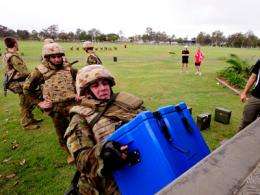Artillery gunner from 1st Regiment, Royal Australian Artillery (1RGT) performs a box lift and place test
Presenting at the 2011 Defence Human Sciences Symposium, DSTO researcher Greg Carstairs outlined that current generic fitness assessments (including push-ups, sit-ups and chin-ups) are often poor predictors of performance in strength based job tasks.
“Assessments that are directly relevant to specific tasks give a better indication of a person's ability to perform a role. This means that the person can perform more effectively with a reduced risk of injury," Mr. Carstairs said.
In a DSTO study involving over 100 soldiers, the effectiveness of push-ups, sit-ups and chin-ups was compared to a 'box lift and place' assessment method (pictured) that involves lifting a weighted box in a manner that replicates what is required in the field.
The results of this assessment method were then recorded against five strength based task simulations, including 'bombing up' a tank, repetitively loading an artillery gun, dragging an injured soldier, building a bridge, and lifting a field pack onto the tray of a truck.
Success with the 'box lift and place' assessment method was closely correlated to success in four of the five strength based tasks, while push-ups and chin-ups correlated with only one of the five job tasks (bridge building).
“The box lift assessment is a far superior predictor of job performance,” Mr. Carstairs said.
“With combat roles scheduled to soon be open to women, these new methods will help us to objectively assess the physical capacity of our soldiers, irrespective of age, sex, height or weight."
This research forms part of the Physical Employment Standards project, which is developing physical tests that are predictive of job performance. As a flow-on effect, it is hoped that PES will help to improve recruitment, training and retention of capable personnel in the Australian Defence Force (ADF).
Provided by Australian Government


















